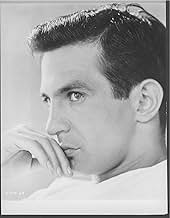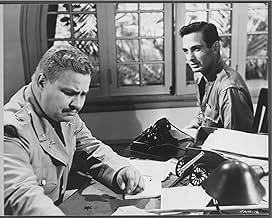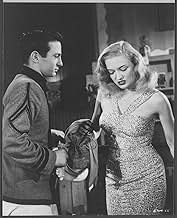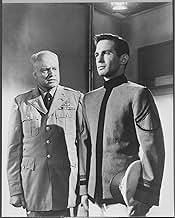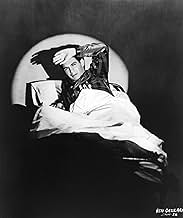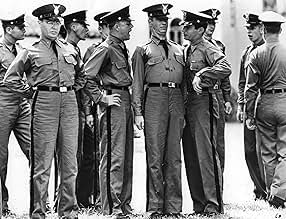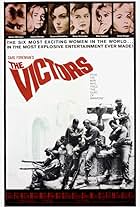IMDb RATING
6.9/10
1.4K
YOUR RATING
Students faced with an ethical dilemma about the dehumanization associated with the tradition of hazing, at a military college in the Southern United States, take matters in their own hands.Students faced with an ethical dilemma about the dehumanization associated with the tradition of hazing, at a military college in the Southern United States, take matters in their own hands.Students faced with an ethical dilemma about the dehumanization associated with the tradition of hazing, at a military college in the Southern United States, take matters in their own hands.
Peter Mark Richman
- Cadet Colonel Corger
- (as Mark Richman)
Vergel Cook
- Jo
- (uncredited)
Featured reviews
Calder Willingham started a career in Hollywood by writing the book, the Broadway play it was based on and finally the screenplay for his work End As A Man. Now on the screen with the title The Strange One it presents a really nasty picture of a southern military academy and some of the cadets there.
There's more than one strange individual in The Strange One. But the title refers to protagonist Ben Gazzara who is both charismatic and evil. A good old southern boy he holds the rest of his set in some kind of sway and they're all afraid of him.
What Gazzara has put in motion is a carefully laid out scheme to embarrass Larry Gates the second in command of the academy by getting his son Geoffrey Horne expelled. With the aid of some lower classmen and a couple of sycophants he gets Horne drunk and leaves him out all night on the parade grounds. Horne is expelled and later Gates loses control when confronting Gazzara.
But at some points all the worms turn. I suspect in both the novel and the play Gazzara gets worse than what he got here.
The play ran 105 performances on Broadway during the 1953-54 season and besides Gazzara, Pat Hingle, Paul Richards, Arthur Storch, and Peter Mark Richman all repeat their roles from Broadway.
Richards is a halfway out of the closet gay man who Gazzara just toys with, catch that deliciously erotic scene as Richards who fancies himself a novelist reads some of his writings to Gazzara as Gazzara plays with his ceremonial sword. The shy and introspective Storch is another closet case who is just crushing out big time on roommate George Peppard who was making his big screen debut as was Gazzara.
It seemed like half the Actor's Studio got involved in this project. But they all do a fine job especially Gazzara who is terrifying and twisted.
And these are the guys who will be defending America.
There's more than one strange individual in The Strange One. But the title refers to protagonist Ben Gazzara who is both charismatic and evil. A good old southern boy he holds the rest of his set in some kind of sway and they're all afraid of him.
What Gazzara has put in motion is a carefully laid out scheme to embarrass Larry Gates the second in command of the academy by getting his son Geoffrey Horne expelled. With the aid of some lower classmen and a couple of sycophants he gets Horne drunk and leaves him out all night on the parade grounds. Horne is expelled and later Gates loses control when confronting Gazzara.
But at some points all the worms turn. I suspect in both the novel and the play Gazzara gets worse than what he got here.
The play ran 105 performances on Broadway during the 1953-54 season and besides Gazzara, Pat Hingle, Paul Richards, Arthur Storch, and Peter Mark Richman all repeat their roles from Broadway.
Richards is a halfway out of the closet gay man who Gazzara just toys with, catch that deliciously erotic scene as Richards who fancies himself a novelist reads some of his writings to Gazzara as Gazzara plays with his ceremonial sword. The shy and introspective Storch is another closet case who is just crushing out big time on roommate George Peppard who was making his big screen debut as was Gazzara.
It seemed like half the Actor's Studio got involved in this project. But they all do a fine job especially Gazzara who is terrifying and twisted.
And these are the guys who will be defending America.
Ben Gazzara stars (in his film debut) in this military drama about a vicious Alpha male getting his comeuppance from 1957. Gazzara is the big dog at this military academy where he rules w/an iron hand making his fellow cadets cower in his wake. Things take a turn when he messes w/the son of the commander (getting him drunk where in a fit of rage & trickery he ends up beating up another) prompting Gazzara to visit the commander's office where in a turn of events, Gazzara threatens him! Finally the rest of the cadets band together to confront Gazzara where he'll either talk the talk or walk the walk. Adapted from his novel, Calder Willingham (The Graduate) eschews a sadistic hierarchy among the soldiers who are at a point in their careers when they're the most malleable & impressionistic, letting Gazzara hold sway over them like some fascist keeping his underlings beneath the knuckles of his tyranny. There is also (whether intentional or not) an undercurrent of homo-eroticism, since women are almost non-existent on the campus, letting our despot control his minions w/every tool in his arsenal. Also starring Pat Hingle (Commissioner Gordon from Tim Burton's Batman series) as one Gazzara's loyal boys, Clifton James as a military higher up & George Peppard (from the A-Team in his film debut) as one of the cadets who fight back.
Originally advertised as the first picture filmed entirely by a cast and technicians from the Actor's Studio, this tale of power play amongst the cadets of a Southern military academy, only comes alive when it features the material that the Production Code of the 1950's demanded be cut.
Based on the autobiographical novel and play End as a Man by Calder Willingham, director Jack Garfein uses the music of Kenyon Hopkins noticably in the scenes between Ben Gazzara as an upperclass man and Paul E Richards as a presumably gay cadet Gazzara nicknames Cockroach, who wears a shower cap when the other cadets don't. Richards is a "creative writer" who names the Gazzara character in his novel "nightboy". Their best scene together is where Richards reads to Gazzara, who plays with his sword! Clearly Gazzara is not adverse to Richard's attention, and their farewell handshake is more a sensual than manly experience. Gazzara's relationship with Richards is also echoed in his friendship with football jock James Olson, where Gazzara reacts to being casually touched. I also like idea of Gazzara's cigarette holder, though his kissing his own wrist at one point is a little too self-consciously Method.
But whilst it is interesting to observe these subversive (for the period) elements, the narrative ultimately disappoints in the treatment of Gazzara as the academy's resident sadist. The Actors Studio adaptation needs to create an ensemble, as opposed to allowing Gazzara to star, which dissipates the tension and reduces his threat. Whilst it may be more psychologically truthful for him to underplay his psychotic nature, with the addition of Freudian insight which makes him more intellectual than physically violent, this doesn't help the drama, which is even more obvious when the far more satisfying climax uses mob intimidation and a physical act of revenge.
The worst of the Actors Studio excess is in the presentation of victim Arthur Storch who is said to be schizophrenic and thus an easy target. Storch has coke-bottle spectacles, buck teeth, cartoon at attention posture, ambition to become a priest, is a mommy's boy, afraid of women, and anti-alcoholic. Gazzara's interest in Storch is inexplicable, even if he does hold him down while Olson spanks him with a broom, but as a good part of the film has us trapped in one room (the stage origins show here) while we're supposed to observe how bad Gazzara is, proceedings crawl into tedium. Or perhaps this kind of s/m power play just doesn't hold that much interest for me. The academy rooms have cell-like iron gates in front of the doors, and even though they aren't locked, the film opens with a guard hitting each as he passes, doing a role call.
Watch for Gazzara's sci-fi buggy car, which has room in the back for a passenger.
Based on the autobiographical novel and play End as a Man by Calder Willingham, director Jack Garfein uses the music of Kenyon Hopkins noticably in the scenes between Ben Gazzara as an upperclass man and Paul E Richards as a presumably gay cadet Gazzara nicknames Cockroach, who wears a shower cap when the other cadets don't. Richards is a "creative writer" who names the Gazzara character in his novel "nightboy". Their best scene together is where Richards reads to Gazzara, who plays with his sword! Clearly Gazzara is not adverse to Richard's attention, and their farewell handshake is more a sensual than manly experience. Gazzara's relationship with Richards is also echoed in his friendship with football jock James Olson, where Gazzara reacts to being casually touched. I also like idea of Gazzara's cigarette holder, though his kissing his own wrist at one point is a little too self-consciously Method.
But whilst it is interesting to observe these subversive (for the period) elements, the narrative ultimately disappoints in the treatment of Gazzara as the academy's resident sadist. The Actors Studio adaptation needs to create an ensemble, as opposed to allowing Gazzara to star, which dissipates the tension and reduces his threat. Whilst it may be more psychologically truthful for him to underplay his psychotic nature, with the addition of Freudian insight which makes him more intellectual than physically violent, this doesn't help the drama, which is even more obvious when the far more satisfying climax uses mob intimidation and a physical act of revenge.
The worst of the Actors Studio excess is in the presentation of victim Arthur Storch who is said to be schizophrenic and thus an easy target. Storch has coke-bottle spectacles, buck teeth, cartoon at attention posture, ambition to become a priest, is a mommy's boy, afraid of women, and anti-alcoholic. Gazzara's interest in Storch is inexplicable, even if he does hold him down while Olson spanks him with a broom, but as a good part of the film has us trapped in one room (the stage origins show here) while we're supposed to observe how bad Gazzara is, proceedings crawl into tedium. Or perhaps this kind of s/m power play just doesn't hold that much interest for me. The academy rooms have cell-like iron gates in front of the doors, and even though they aren't locked, the film opens with a guard hitting each as he passes, doing a role call.
Watch for Gazzara's sci-fi buggy car, which has room in the back for a passenger.
An upper class man at a rigid southern military academy abuses his power in a highly conceived plot in order to orchestrate an expulsion of another cadet. We're left to wonder why he's motivated to do so, and the acting and scenes in this part of the film do seem to be too staged, but the film makes for riveting viewing as in its portrayal of the overall ambiance of the the academy, a strange hierarchy with bizarre scenes of interaction between the lower and upper class men. And a final military brand of cadet justice that unites the two classes gets born out of the incident, and reveals a lot, and ends in a chilling finale with superior night scenes.
Jack Garfein made "The Strange One" in 1957. It was adapted by Calder Willingham from first his novel and then his play "End as a Man". Actually the title "The Strange One" doesn't really do it justice; a better, if somewhat declamatory, title might have been 'The Evil One' since its central protagonist, Jocko De Paris, is one of the most sadistic and warped anti-heroes in all of fiction. The setting is a military academy in the Deep South and Jocko is cock of the walk. He rules with a combination of charm and viciousness but it all goes belly-up for him when he targets a young cadet and his father, who happens to be an officer there. His scheme involves four other cadets whose fear of him he's counting on. It's a melodramatic scenario that culminates in a bravura, sustained passage of mounting hysteria but it's brilliant in the way that the best of Tennessee Williams or William Inge are brilliant. Willingham's dialogue has the ring of poetry to it and Garfein, whose first film this was, (he's only made one since), directs it superbly.
Of course, it would have been nothing were it not for its cast, many of whom were totally unknown at the time. Ben Gazzara may already have been a star on the New York stage, (he was Brick in "Cat on a Hot Tin Roof"), but was an unknown quantity in the movies, (it was also his first film). His performance as Jocko should have made him a much bigger star than he ever became and it remains a career-best performance. Those who fall under his spell include Pat Hingle, James Olson, Arthur Storch and George Peppard. They are all terrific; Peppard, also making his screen debut, shows real promise and Hingle in outstanding.
There's also one overtly gay character, (though the whole picture is suffused with homo-eroticism), a cadet who fancies himself a writer and who is obviously in love with Jocko. He's played by Paul Richards as a grotesque and flamboyant queen, part Truman Capote and part Gore Vidal. In any other film this character would be offensively out of place but here he's just one more poisonous plant in this insidious hothouse. The film wasn't successful and is almost impossible to see now, at least here in the UK but it's a masterpiece and one of the best American films of the fifties. Essential.
Of course, it would have been nothing were it not for its cast, many of whom were totally unknown at the time. Ben Gazzara may already have been a star on the New York stage, (he was Brick in "Cat on a Hot Tin Roof"), but was an unknown quantity in the movies, (it was also his first film). His performance as Jocko should have made him a much bigger star than he ever became and it remains a career-best performance. Those who fall under his spell include Pat Hingle, James Olson, Arthur Storch and George Peppard. They are all terrific; Peppard, also making his screen debut, shows real promise and Hingle in outstanding.
There's also one overtly gay character, (though the whole picture is suffused with homo-eroticism), a cadet who fancies himself a writer and who is obviously in love with Jocko. He's played by Paul Richards as a grotesque and flamboyant queen, part Truman Capote and part Gore Vidal. In any other film this character would be offensively out of place but here he's just one more poisonous plant in this insidious hothouse. The film wasn't successful and is almost impossible to see now, at least here in the UK but it's a masterpiece and one of the best American films of the fifties. Essential.
Storyline
Did you know
- TriviaBen Gazzara, Pat Hingle, Peter Mark Richman (as Mark Richman), Arthur Storch, and Paul E. Richards played the same roles on stage. The play "End as a Man" opened on Broadway at the Vanderbilt Theatre, 148 W. 48th St. on 14 October 1953 and ran for 105 performances.
- GoofsWhen Jocko and Julie go to the Savanarola Club in town, there is a neon sign in a window with open blinds as seen from the outside. But when they step inside, the blinds in the window are closed and no light from the neon sign is seen.
- ConnectionsFeatured in Ben Gazzara Remembers the Strange One (2009)
- How long is The Strange One?Powered by Alexa
Details
- Runtime1 hour 40 minutes
- Color
- Aspect ratio
- 1.85 : 1
Contribute to this page
Suggest an edit or add missing content



